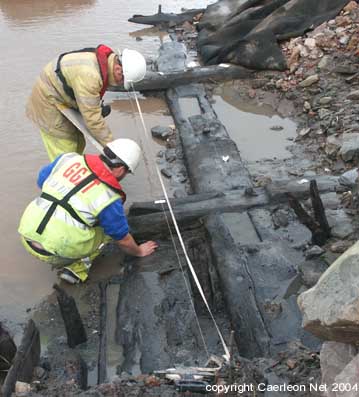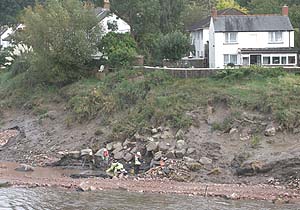|
A team of Archaeologists
from GGAT (Glamorgan-Gwent Archaeological Trust) spent several days
uncovering and recording part of the footings of Caerleon's old wooden
bridge in late September, 2004.
During low tides, while heavy machinery continued the work to reinforce
the river bank, the archaeologists examined a large timber that once
held the Ultra Pontem end of Caerleon's ancient wooden bridge in place.
As can be seen in the photo above, the timber lay on a bed of small
stones and had three large mortise holes cut in it, these were to secure
the upright timbers which supported the bridge.
We have a very good idea of what the bridge looked like and how it was
constructed from contemporary drawings. William Coxe's Historical
Tour In Monmouthshire, published in 1801, was superbly illustrated
with views by Richard Colt Hoare. These illustrations included pictures
of Caerleon Bridge at high tide and Chepstow Bridge at low tide. Both
bridges used a similar method of construction, namely supporting the
deck of the bridge on high wooden piers. (Actually half of Chepstow
bridge was supported in this way, the western end of the bridge was
supported by stone piers.) Hoare's illustration of one of the wooden
piers can be seen to the right. The section coloured red is the timber
revealed in these excavations.
A close examination of Hoare's illustration of Caerleon Bridge suggests
that, like Chepstow Bridge, there were five 'upright' timbers in the
piers - three vertical and two sloping to brace the structure. Maybe
the three holes in the timber found were for the vertical sections of
the pier.
GGAT has sent off samples of the bridge footings for dendrochronological
dating. It is thought that the timber may be medieval and could have
held Caerleon's Bridge in place for hundreds of years. We will bring
you news of the results of these tests as soon as GGAT release them.
The archaeologists also found evidence of the repair work which would
have been so important in keeping the bridge serviceable.
Newport's wooden bridge was replaced by a stone bridge in 1801. Caerleon
had to wait about another ten years for its stone bridge. Built a short
distance downriver of its older counterpart, this is of course the same
bridge that nowadays carries double decker buses, lorries and the huge
amount of traffic unimaginable in the days when it was constructed.
Interestingly, the foundation stone on Caerleon Bridge is thought to
have somehow come from Newport's first stone bridge which was replaced
by a wider bridge in the 1920s.
LINKS:
You can read the full text from William Coxe's Historical Tour In
Monmouthshire by following this link.
This includes a description of the bridge and the highly improbable
story of a Mrs Williams being swept down the river astride a bridge
timber on the night of 29th of October 1772!
Illustrations
of Caerleon's wooden bridge
Glamorgan-Gwent Archaeological
Trust website
Download GGAT report of Caerleon Bridge 'Dig'  PDF 2.2 MB PDF 2.2 MB
Caerleon Net Home Page
|
|
|
|


